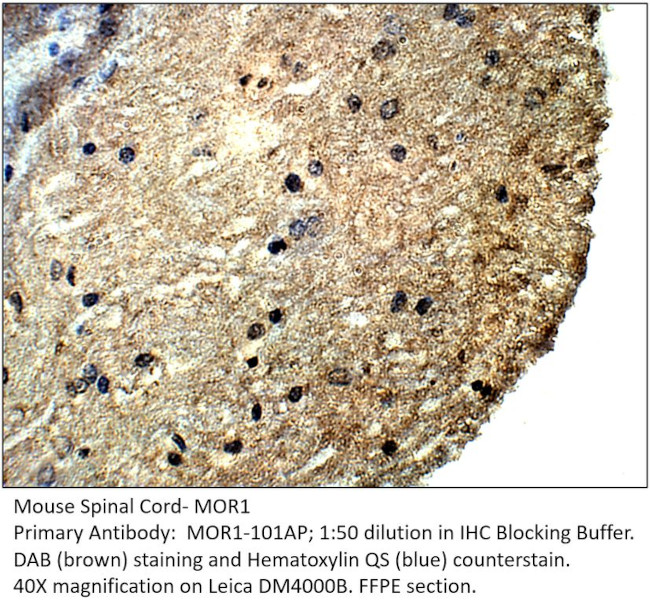Search Thermo Fisher Scientific
Product Details
MOR1-101AP
Species Reactivity
Host/Isotype
Class
Type
Immunogen
Conjugate
Form
Concentration
Purification
Storage buffer
Contains
Storage conditions
Shipping conditions
Target Information
The OPRM1 gene encodes the mu opioid receptor, which is the primary site of action for the most commonly used opioids, including morphine, heroin, fentanyl, and methadone. It is also the primary receptor for endogenous opioid peptides beta-endorphin and the enkephalins. The OPRM1 receptor is a membrane of the G protein-coupled receptor family. There are at least 3 types of opioid receptors, mu, kappa, and delta, each with a distinct pharmacologic profile.
For Research Use Only. Not for use in diagnostic procedures. Not for resale without express authorization.
References (0)
Bioinformatics
Protein Aliases: hMOP; KIAA0403; M-OR-1; MOP; MOP receptor; MOR-1; MOR-1C; Mu opiate receptor; Mu opioid receptor; mu opioid receptor hMOR-1a; mu opioid receptor splice variant mMOR-1Z; mu opioid receptor splice variant rMOR-1S; mu opioid receptor splice variant rMOR-1Z; Mu-type opioid receptor; MUOR1; Opioid mu receptor; Opioid Receptor; Opioid receptor B; opioid receptor, mu 1; OTTHUMP00000017463
Gene Aliases: LMOR; M-OR-1; MOP; MOP-R; MOR; MOR-1; MOR-1O; MOR1; MORA; muOR; OPRM; OPRM1; Oprrm1; Ror-b
UniProt ID: (Human) P35372, (Rat) Q64120, (Mouse) P42866
Entrez Gene ID: (Human) 4988, (Rat) 25601, (Mouse) 18390

Performance Guarantee
If an Invitrogen™ antibody doesn't perform as described on our website or datasheet,we'll replace the product at no cost to you, or provide you with a credit for a future purchase.*
Learn more
We're here to help
Get expert recommendations for common problems or connect directly with an on staff expert for technical assistance related to applications, equipment and general product use.
Contact tech support

